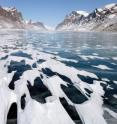Queen's scientists on international team discover 'ecologically unique' changes in Arctic lake
Queen's University biologists are part of an international research team whose discovery of a rare sediment core in a remote Arctic lake provides compelling evidence of unprecedented environmental changes occurring over the past few decades. "Our findings show that the last several decades have been the most ecologically unique in 200,000 years," says Neal Michelutti, a research scientist at the Paleoecological Environmental Assessment and Research Lab (PEARL) at Queen's. With Biology professor John Smol, Canada Research Chair in Environmental Change, and master's student Cheryl Wilson, the Queen's researchers are part of a multidisciplinary team led by University of Colorado scientist Yarrow Axford.
Other members of the team are from the University of Alberta, University of Buffalo and University of Massachusetts.
The sediment core, retrieved from a lake bottom on Baffin Island, predates by about 80,000 years the oldest cores from the Greenland Ice Sheet, capturing two ice ages as well as three interglacial periods. "Lake sediments are natural recorders of climate and environmental changes, as they preserve archives of past geochemical and physical conditions, as well as a diverse record of important biological indicators," Ms Wilson explains. The research team used algae and aquatic insect fossils preserved in the sediment core to reconstruct past climatic and other environmental conditions.
Their analyses show that changes in species, as well as lake-water chemistry, were tightly linked to past shifts in climate. The sediment records have allowed the team to reconstruct climatic and environmental conditions of the past three warm periods between the last two ice ages, and compare them to the human-influenced climate of today.
"The 20th century is the only period during the past 200 millennia in which aquatic indicators reflect increased warming, despite the declining effect of slow changes in the tilt of the Earth's axis which, under natural conditions, would lead to climatic cooling," notes the University of Colorado's Dr. Axford.
Such long lake records are extremely rare in glacial regions because the massive ice sheets during past ice ages typically scraped and scoured the underlying bedrock and removed previous sediment records, much like a huge bulldozer. The Baffin Island lake was spared this scouring due to the presence of what is known as cold-based ice, which is non-erosive and acts to preserve landscape features such as lakes and the sediments contained within their basins.
"Our results show that the 'human footprint' is overpowering long-standing natural processes, even in remote Arctic regions," says Dr. Smol, winner of the 2004 NSERC Herzberg Gold Medal as Canada's top scientist. "This historical record shows that we are dramatically affecting the ecosystems on which we depend. We have started uncontrolled experiments on this planet, and we have entered unchartered territory. The situation is far worse than we thought and this is only the beginning."
Source: Queen's University
Articles on the same topic
- Arctic sediments show that 20th century warming is unlike natural variationSun, 25 Oct 2009, 4:24:18 UTC
- Arctic lake sediments show warming, unique ecological changes in recent decadesMon, 19 Oct 2009, 21:22:48 UTC
Other sources
- Arctic Sediments Show That 20th Century Warming Is Unlike Natural Variationfrom Science DailySun, 25 Oct 2009, 4:21:06 UTC
- Arctic changes likely caused by humansfrom UPIThu, 22 Oct 2009, 16:07:20 UTC
- Arctic Lake Sediments Show Warming, Unique Ecological Changes In Recent Decadesfrom Science DailyMon, 19 Oct 2009, 23:28:14 UTC
- Arctic lake sediments show warming, unique ecological changes in recent decadesfrom PhysorgMon, 19 Oct 2009, 21:21:07 UTC

